
The old man’s eyes light up with such a force that I think he may leap out of the rickety chair he was just helped into. “Alaska!” he says in a hushed, dreamy voice with a huge grin on his sun-worn face. A big grin of realization comes to my face as well. “Yes, we did bike to Baja California, Mexico from Alaska!” All 5,500 miles of our indirect and mountainous route brought us to this old man’s regular desayuneria just south of Tecate.

His excitement sparked something in me that reminded me of a phone call to my Marnee (that’s what I call my paternal grandmother) before we started this adventure. When Devon and I told most of the people closest to us about our plans for this year, we received overwhelming support, but there was always some hesitation. It tended to relate to practical considerations. Is it wise to quit a good job with no plans for another one? Is Central America a safe place to travel—let alone on a bicycle? The last-minute nature seemed to amplify the concerns. We would leave in less than six weeks. Was spontaneity a good quality in a decision like this? However, when I called Marnee, she immediately squealed with excitement. With her immediate, joyous, unquestioning support, I knew in that moment that I had made the right choice. Marnee and I have always shared a similar spirit, but I especially appreciated that her extra sixty years of perspective led her to know this was the right choice for me. While the old man in the desayuneria might have spent all of his eighty or so years not far from that very spot, I saw that twinkle of an adventurer’s spirit in him, and I appreciated his support too.
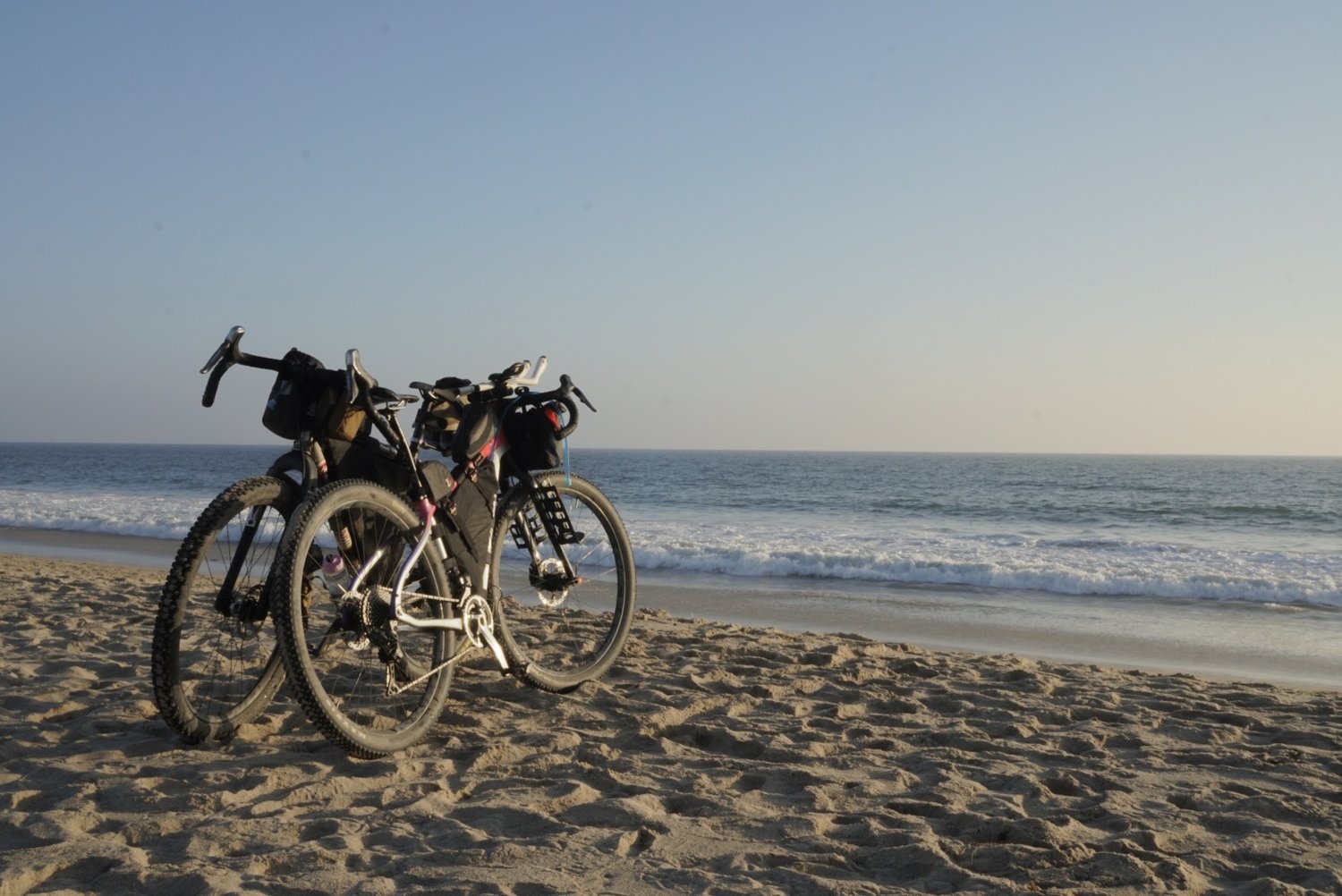
The day before we met that old man, we had crossed the border at Tecate. Five years earlier, we had made the same border crossing for a long weekend visit to Valle de Guadalupe, an up-and-coming wine region. At the time, we hurried through Tecate with some anxiety about crossing the border. We remembered it unfavorably. This time, we crossed the unmanned pedestrian entrance which included an x-ray machine that asked us to scan our belongings—don’t worry we did a thorough check of our own stuff. In no time at all, we were on the other side of the border in a lively and inviting plaza. We jumped at the first opportunity to stop at a taqueria in Mexico, hardly out of sight of the border. Digging into some delicious carnitas tacos settled my nerves about the border crossing for a bit, but then the sun started to drop, and it was time to bike fast and gain some distance from the border before our first night of camping in Mexico.
By the time we reached Mexico, we had spent a couple weeks suffering in the desert heat of the southwest U.S. followed by visits to Los Angeles and San Diego. Being in the big, familiar cities felt like a break from the traveling cyclist’s life on the road. I wandered and visited favorite coffee shops in my old neighborhood in LA and met up with old friends. I tried to blend in and pretend I wasn’t wearing the same shirt I had been sweating in day after day on the bike. Through much of the U.S., we had planned many meetups with friends and family that kept us on a pretty strict schedule, but when we crossed into Mexico mid-September, we had almost no timeline in mind. Our only plan was to reach Oaxaca by Thanksgiving, Costa Rica by Christmas, and the bottom of South America next summer. This loose timeline granted us real freedom to explore and linger in places that captivated us. Our plan for Baja was to generally follow the Baja Divide, a 1700-mile off-pavement bikepacking route that zig-zags all the way down the peninsula.

At this point, we had been living the vagabond lifestyle for about three months, and we had grown comfortable with uncertainty about our route and where we would spend the night. This is in part because of our personalities and in part because of travel necessity. It’s nearly impossible to do enough research on a trip of this magnitude to know where you will want to spend each night. Throw in the additional uncertainty of traveling by bicycle and the delays that mechanical issues, injuries and illness can cause, and it really is impossible. That’s just as well because traveling doesn’t really become an adventure until things don’t go as planned. Thinking back to our original decision to take off on our bikes for the year, it was right that we did it spontaneously. While we had been dreaming of doing this trip for some time and had the loose structure of it in mind, we had planned to take off a year or two later. However, it’s rare that we would both feel ready to leave our jobs and the life we had built in San Francisco at the same time, so when that happened, we had to go. And we had to leave in six weeks to beat the snow to the Rockies. In the same way that we find an unforgettable sunset by heading down a different path when we see the timing and the weather starting to line up, following our gut on this trip would yield something unforgettable too. That decision meant a planning scramble, and we had to trust that some things would just work out. It’s always uncomfortable to leave so much unplanned, but it creates more unexpected experiences. Every one of my best and most memorable experiences have been unexpected.
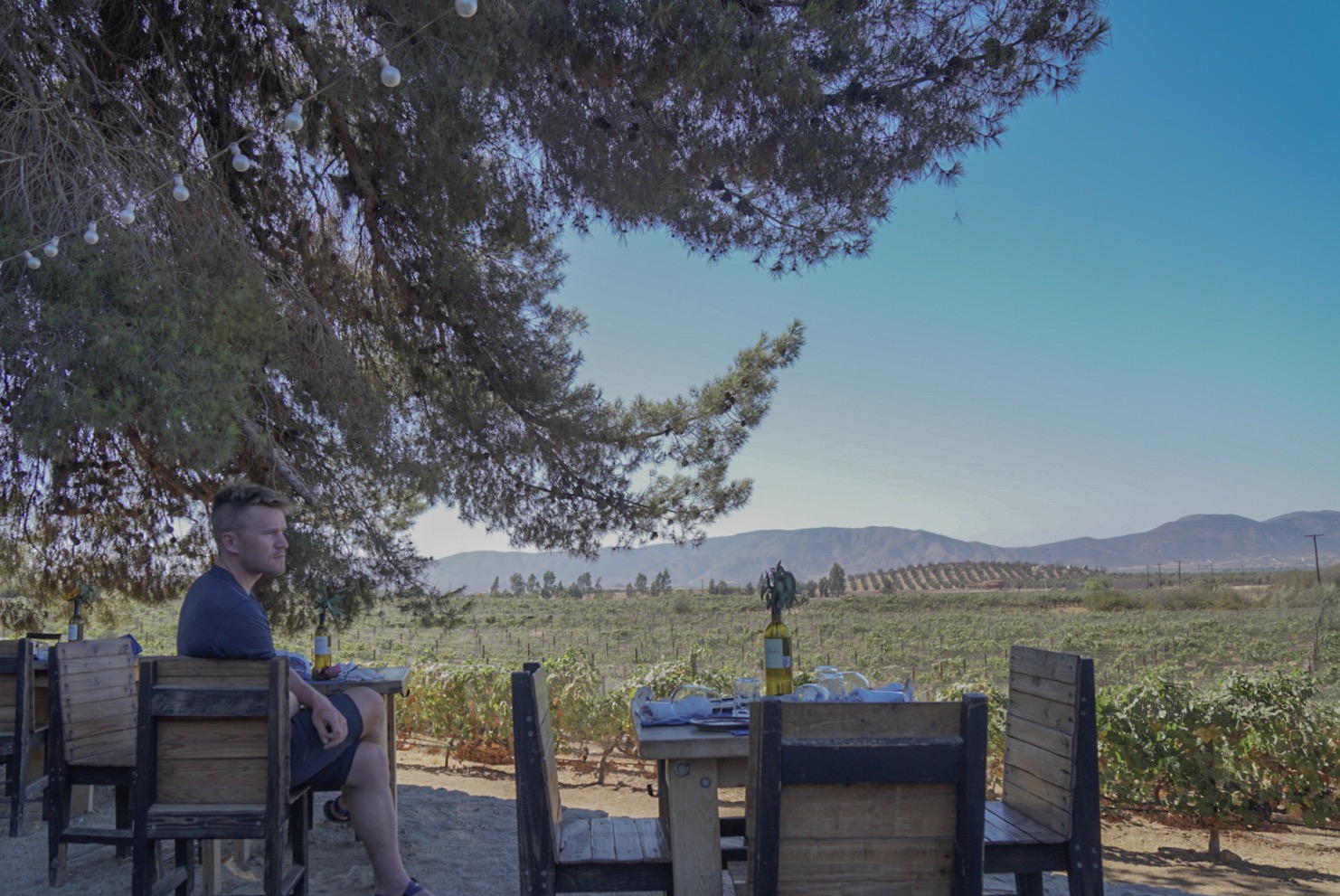
Combining our comfort with uncertainty and our flexible timeline leads to a kind of spontaneity that lets us fully take advantage of local tips and spend our time in the places most worthy of it. Right from the border, we knew we wanted to venture off route to revisit Valle de Guadalupe, which had really boomed since our last visit there. In 2014, we took a spur-of-the-moment long weekend road trip there based on a Sunset Magazine tip and were amazed to find incredible food, a valley more scenic than Napa, and not a single other American. (I must be the only American left who reads magazines.) Like we’d learn throughout Baja, there are a lot of hidden gems that have parallels to much busier Alta California hangouts. However, most of those are much harder to get to; this was just a couple hours drive from San Diego. Some San Diego residents have discovered this gem since then, but it still feels like a largely undervalued spot. While it felt like a bit of an odd start to Mexico to sip wine at trendy vineyards and enjoy multi-course tasting menus, it was an appropriate start to a lot of excellent eating. We quickly made friends with the young foodie working behind the bar to serve our wine tasting at the beautiful Encuentro hotel, which led to tips on the best fish taco spots and an offer to crash on his couch in Ensenada. We took the latter as a promising sign that the generosity we have experienced on this trip would continue, and that we wouldn’t need to plan ahead for places to sleep.

Once we had our fill of beef tongue and tomato salads and Chardonnay blend pairings, it was time to return to our dirtier and much less glamorous lifestyle. Frankly, it was a little hard to leave all that good food and think about returning to backpacker food and camping again. Fortunately, that feeling was fleeting. On our very first day of off-road riding, we discovered a coastline that reminded me of riding in the Marin Headlands just like I have hundreds of times before, but there were no people or paved roads or really much of anything. That night, we camped on a bluff just forty feet over the ocean and fell asleep to crashing waves. We were greeted in the morning by dolphins.
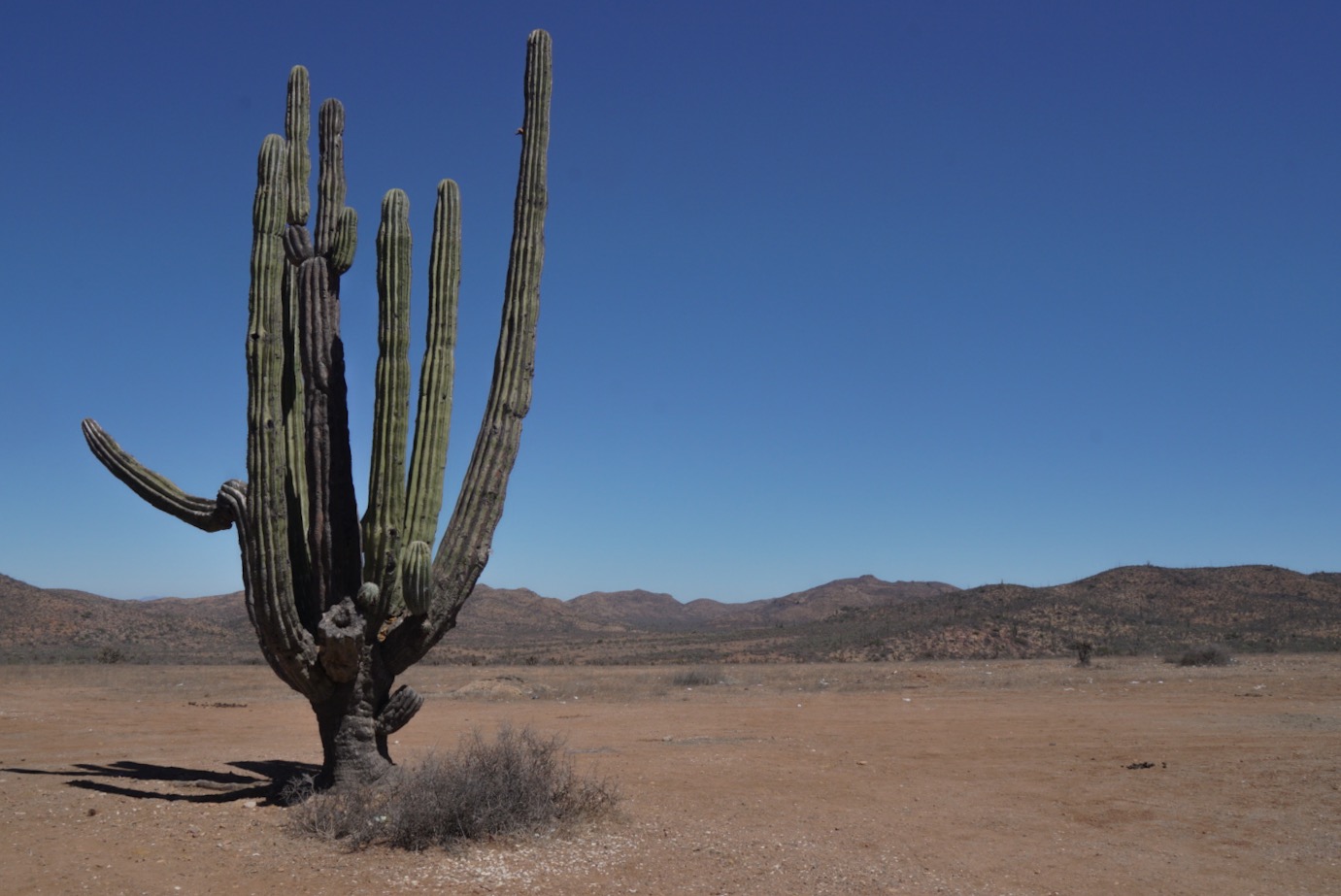
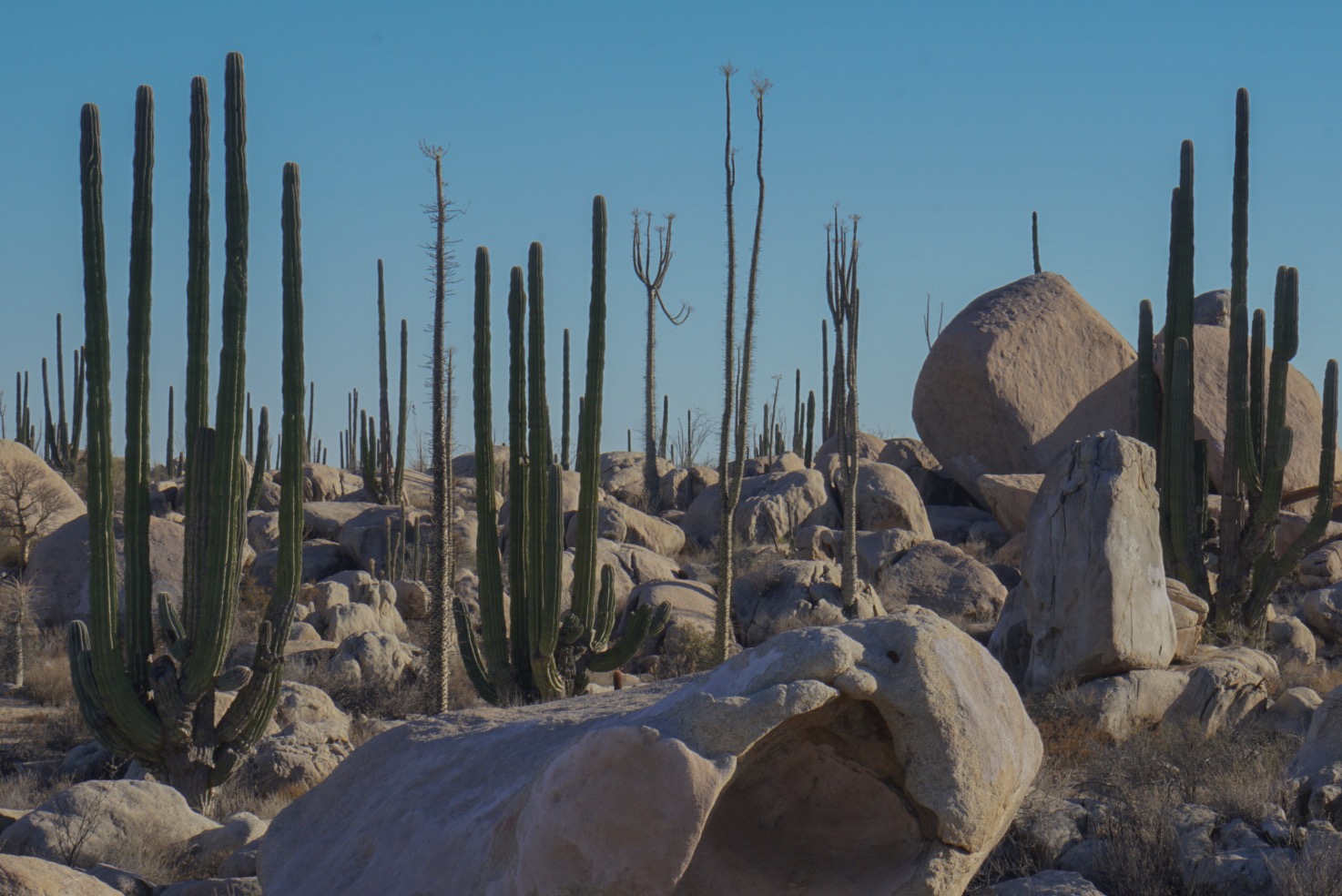
Our route zig zagged across Baja as we headed south, crossing a remarkable range of desert and coastal scenery. We biked across orange-tinted sand surrounded by forty-foot-tall cactus. We pedaled through house-sized white boulders contrasted by dense vibrant green cactus. We followed undulating hills made green from sea spray, with each having a different texture and color depending on distance from the ocean. Each of these landscapes was beautiful in its own way and made even more so by the variety. However, the one I will never forget was the Sea of Cortez from afar. After hours of slow climbing and frequent bike pushing over loose gravel and sand, I was dripping with sweat, and my clothes were covered in salt stains from the brutal sun and ninety-percent humidity. When we finally crested the ridge, my jaw dropped at the sight of the deepest, darkest blue body of water. Until that moment, my thoughts had been of icy drinks, shade and smooth pavement, and I instantly forgot everything except that view.
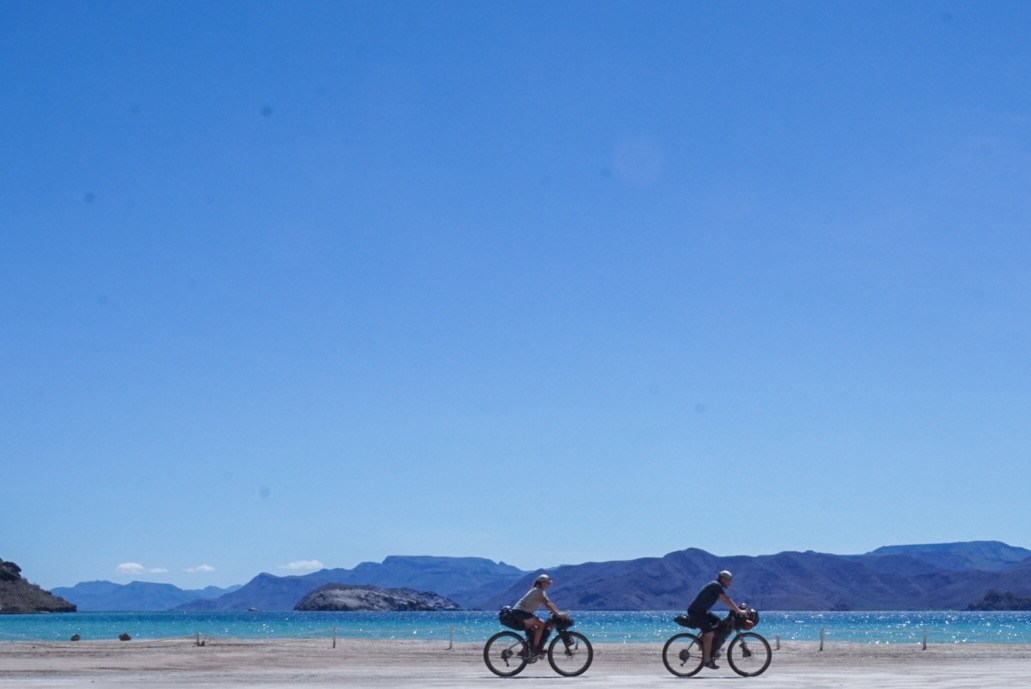
The blue of the Sea of Cortez continued to mesmerize me as we got closer and closer. When we reached it, we found sparkly turquoise bays that begged us to stay, and we obliged. On our first night in Mulegé at the top of the Bahía Concepción, we took a dip after dark to clean off. (When you are as sweaty and dusty as we frequently are, bathing in the ocean does actually make you cleaner.) As I scrubbed at my legs to loosen the dirt, the water started to glow. It was bioluminescent. Even in total darkness, that water managed to still be so beautifully blue. Just south of Mulegé, we found Playa Santispac, a white-sand beach with perfectly clear and calm water encircled by a scenic rocky coastline and nearby islands. While we had planned to continue on a bit farther that day after a quick swim, we were stopped by an enthusiastic Mexican American cyclist from San Diego who insisted that we have a beer with him. He had grown up visiting that beach with his parents, and he was bringing his family and some friends there for the first time twenty years later. They had driven eighteen hours from San Diego with an impressive camping setup including kitchen complete with a comal. We were so warmly welcomed into their camp that we spent a full day with them. The perfect ocean breeze and full moon made for one of the best nights of camping I have ever experienced.
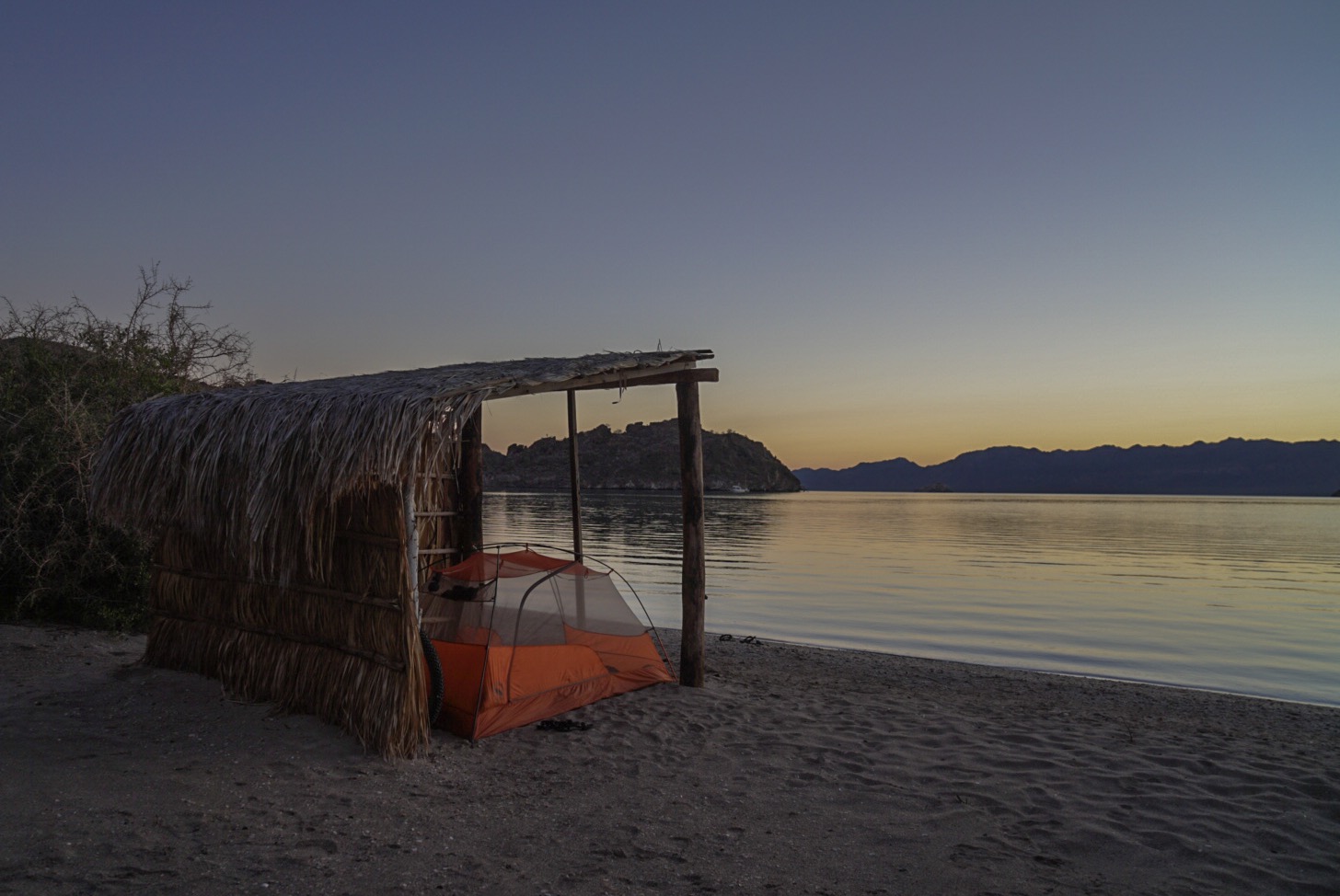
After that lazy beachside day, we didn’t even make it ten miles the next one before finding another beautiful and totally empty beach for camping. These were some of the most scenic beaches I have ever seen, and yet they were nearly all empty. Why is everyone crowding into Los Cabos? We lingered yet another day floating in the Bahía from sunrise to sunset on our perfect, private beach. This was a different pace from the days in Canada where we rode more than a century a day and went three weeks without a day off the bikes. While that glacier-fed water sometimes shared the same beautiful blue hue as this bay, it was not the kind of water for lingering. Pushing the pace through Canada gave us the freedom to sit still in the right places.
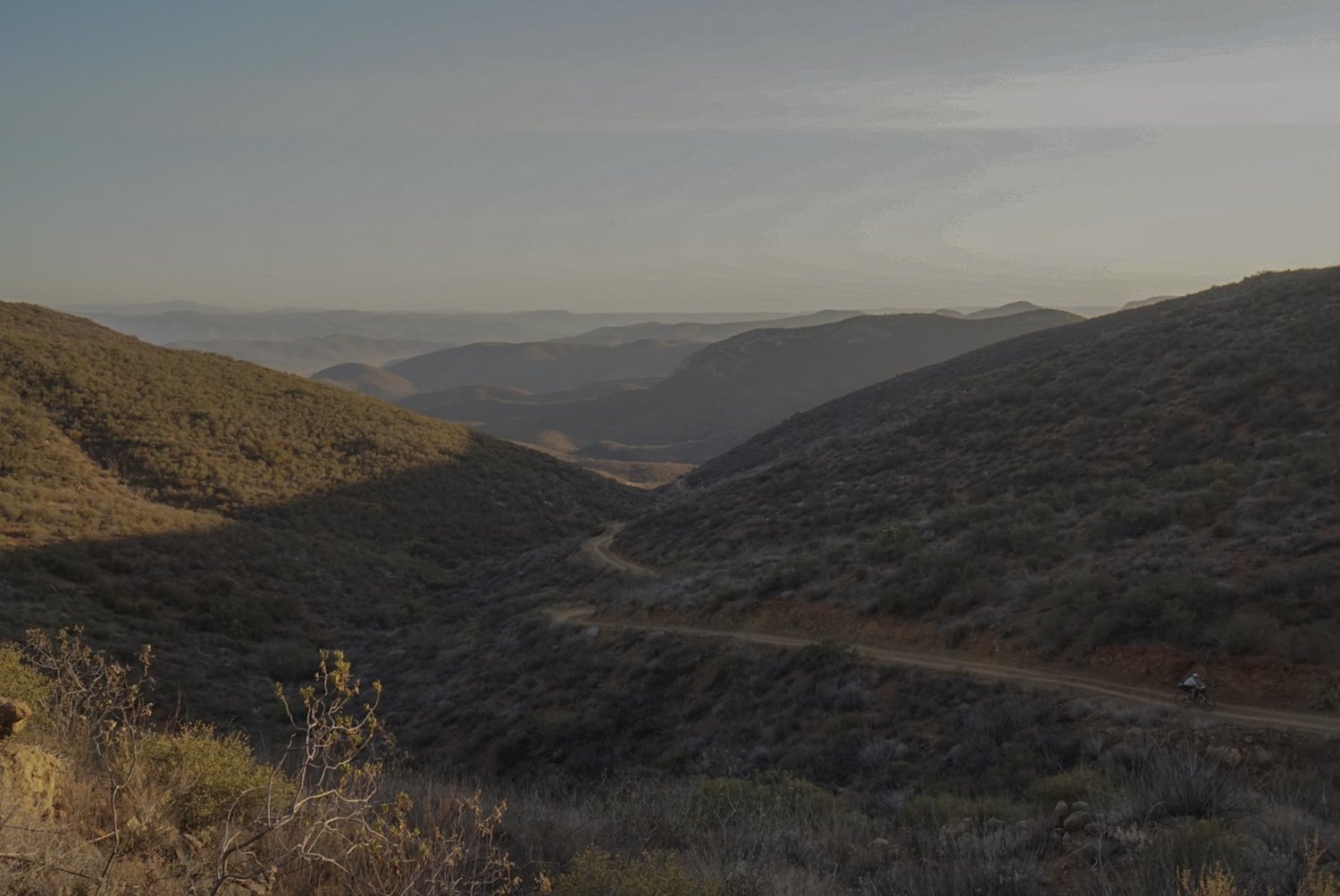
The other reason we spent more time on this section was the extremely challenging Baja Divide route. I found this route to be orders of magnitude tougher than the Great Divide Mountain Bike Route (GDMBR). I joked with Devon that whenever we came to a fork in the road, I had grown accustomed to picking the correct one on the GDMBR based on road quality. It was the one that was more traveled and had a better surface. On the Baja Divide, pick the other one. Deeper sand? That’s probably our route. Since this sandy section was just one part of our much longer journey, we weren’t able to optimize our bikes for it. We swapped our tires for as big as we could fit on our bikes (from 2.25 to 2.6 inches), but we knew there were sections where we really needed 3-inch tires to be happy. We expected some walking and bike pushing, but it was more frequent than we hoped and didn’t always seem worth it. While there are many times I have sought riding like this purely for the challenge, that’s not how I felt after three months of bike travel. Now I wanted to climb a mountain for a view that made my jaw drop. I wanted to cross a sandy desert to find a lush palm tree grove oasis. I wanted to suffer along a steep, undulating road to see an undeveloped coastline. I was lucky to get to do all of that, and the suffering added a depth to each scene that made it more impressive to me. But what I did not want to do was push my bike through sand where the highway was equally scenic and had relatively low traffic, so we veered off the Baja Divide when we saw better looking highway alternatives. We might have just been lucky because it was the off-season, but those highway sections turned out to be low traffic and very scenic. For anyone considering cycling in Baja, I don’t want to paint the wrong picture of the Baja Divide. There was plenty of challenging riding that was unquestionably worth it for the scenery, and it’s really amazing that it’s possible to ride 99% off-road all the way down Baja. But if never touching pavement isn’t your goal, we found some good alternate sections (especially if you aren’t on 3-inch tires).

Despite incorporating some highway riding into our route, most of Baja felt pretty deserted. We spent almost three weeks traveling through remote places with small towns where it was hard to find conveniences like internet and soap and gringo-quality sunscreen. We spent days traveling through the desert where water was so limited that we got very, very dirty. At one point, we traveled 125 miles between water sources. We were covered in salt stains and dust and soot. The latter was from being unable to spare the water to really clean off from cooking with our messy kerosene-burning stove. (It’s the only fuel we could find.) Our surroundings were dirtier too. One day, we biked through a giant, smelly trash heap for a couple miles. There was often trash along the roads and piled at the outskirts of towns. We were eating at places with so many warning signals about poor sanitation practices. There were flies absolutely everywhere, all through the kitchen and all over our food. But we ate anyways. We were always hungry, and the food was incredible. We knew the fish tacos in the beachside towns would be tasty, but every little roadside stand and home kitchen served us delicious meals. So we ignored the flies. I definitely can’t say we completely escaped GI distress, but it never really held us back for long.
That hardship won’t be what I remember about our trip through Baja. In fact, it took the reflection of the writing process for me to remember it, but I do think it explains why it felt especially good to recover in La Paz. La Paz is actually very scenic in its own right and has some cool hangouts, but it was also just really nice to enjoy big city (La Paz has a population of about 250,000) luxuries like iced coffee and margaritas, and have easy internet access. Indulging in the occasional city conveniences refreshes me for more adventurous and challenging travel. It feels good to wipe the soot off my face every once in a while, eat a salad and maybe even get a massage. We had no real plans for La Paz and knew very little about it, but we ended up staying nearly a week in total.
Our wonderful hosts contributed to extending our stay in La Paz. Some friends of friends live there, and they had been told about us a month before our arrival. Because of a lack of cell service and our general lack of planning, we first reached out to them about four hours before we arrived. I wasn’t sure what to expect when I called to say that we are the cyclists Lalo told you about a month ago, and we will be in La Paz in a few hours. At least, I think that’s what I said in my very poor Spanish. Either way, they said that they were waiting for us, and they sounded delighted that we had materialized. A few hours later, Tere and Miguel were indeed waiting for us with a delicious meal of huitlacoche and nopales tacos, a vegetarian meal which was a welcome break from all the fly-covered carnitas and fish. Even with my beginner’s Spanish, Tere and I hit it off, and they treated us like their own children. When Tere warmly told me that “mi casa es tu casa,” I replied with a smile that “mi casa es tu casa tambien, pero mi casa es un bici.” Tere said she would wait to visit until we got back to San Francisco.
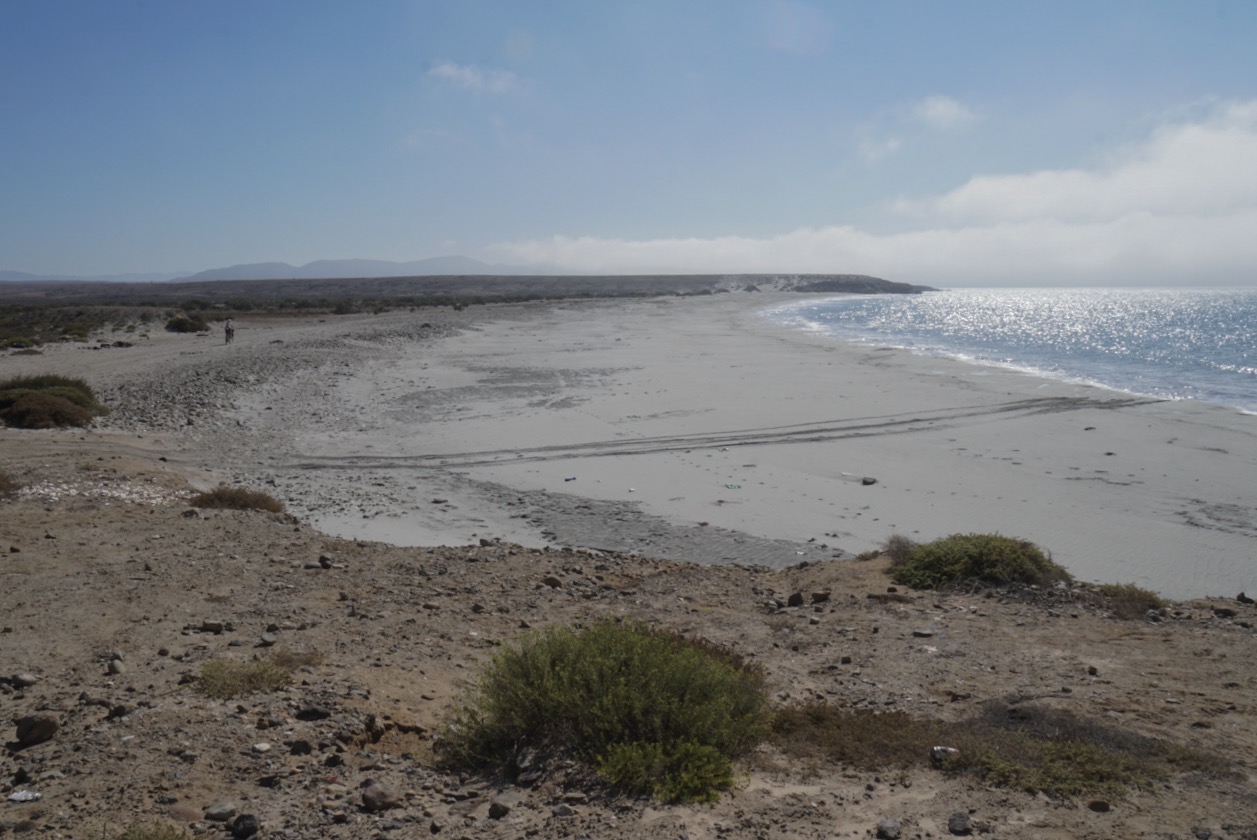
When it was finally time to leave the Baja peninsula and head to mainland Mexico, we learned that the ferry we planned to take was under maintenance for the next six weeks. In the spirit of keeping plans flexible, we looked at a map and then booked flights to Guadalajara. Guadalajara wasn’t on our original route, but it’s just a couple hundred miles inland from where we intended to arrive on the mainland and has a big airport. I was a little disappointed to hop on a plane after powering nearly 7,000 miles on my own legs. It felt almost like breaking a magic spell to walk into an international airport. After covering so much ground at a cyclist’s pace, it’s basically like time travel to accelerate like that and skip over the gradual change in landscape, in architecture, in the food and the people. Instead, in merely an instant, we were dropped into a big, bustling city off of our planned route. Where to next? That was dictated mostly by whoever I met in Guadalajara’s coffee shops and their favorite places to visit in Mexico. We might have lucked out by meeting some travel aficionados, but I suspect we are just traveling through a country full of incredible places.
